Steel walls and soft grasses in travel-influenced Mirador Garden
A week ago I had the opportunity to photograph another of landscape architect Curt Arnette‘s gardens. Frothy, rose-colored clouds of Gulf muhly, tawny spikes of Lindheimer muhly, and a chartreuse Habiturf lawn wrap the large front garden in a cozy quilt of softness that counterbalances the flat planes and sharp angles of this contemporary Southwest Austin home.
Even at curbside, you know this garden is going to be big on ornamental grasses. No stiffly pruned topiary shrubs here, and definitely no overused, faux-Tuscan spires of Italian cypress.
Instead, native grasses grouped in contemporary blocks of color and texture keep the garden organized, even as it blends into the surrounding landscape.
But the big surprise in the front garden is a tiered arrangement of rusty steel walls that comes into view as you enter the driveway. Inspired by the adventurous homeowner, who had admired a similarly terraced garden on her world travels, Curt’s design replaced an existing stone retaining wall with slim panels of steel that trace the contours of the sloping lot.
Native and adapted dryland plants fill the terraces and broad ramps that provide gardening access.
At one end, bristling heads of Yucca rostrata shimmer atop a wedding-cake tier of steel curves.
From the house, it’s a dramatic amphitheater filled with an audience of native and adopted Texans.
The Habiturf lawn, which carpets the slope from the steel walls down to the driveway, is the first residential use I’ve seen in person. I like its tufted, shaggy texture. An ecological lawn developed by the Lady Bird Johnson Wildflower Center, Habiturf is a low-mow, low-water alternative for the U.S. Southwest and Southern Plains.
The Habiturf lawn is allowed to spread naturalistically under and around yuccas, ornamental grasses, and other plants rather than being kept separate, which must make mowing a challenge. But then again, Habiturf rarely needs mowing. Curt told me that native wildflowers are seeded in the lawn for a meadowy spring display.
A line of native Lindheimer muhly grasses edges the driveway and glows against the red steel.
Gulf muhly and blue grama grasses catch the light atop a retaining wall next to the house.
Every view of the front of the house is softened by grasses, including this scrim of Lindheimer muhly.
At the front gate, a raised bed of agave and prostrate rosemary greets you. I didn’t enter here, however…
…but walked down the driveway to another gate set between head-high steel planter boxes.
These are filled with gopher plant, red yucca, and other highly drought-tolerant plants. The blocky walls create privacy for the courtyard garden within.
Fencing panels between the boxes admit light and frame views.
Another fence panel, this one in a stone wall along the driveway, offers a view of a see-through outdoor fireplace.
Entering the courtyard garden, you see a guest house or studio overlooking a board-formed concrete trough.
This rectangular, negative-edge pool is the focal point of a raised-bed vegetable and cutting garden.
It’s a spectacular water feature that reminds me of a similar one in Christine Ten Eyck’s courtyard garden (click and scroll for pics).
At the corner of the guest house/studio, rainwater is collected and stored in a silo-like cistern, which must be handy for watering the raised beds.
Roses, iris, and zinnias give this space a cheery, casual vibe, but it steers clear of cottage style with an open layout and the precise lines of the steel-edged beds.
Monarchs were nectaring on zinnias this morning, making a temporary, red-orange color echo.
A wider courtyard view
It’s not all edibles and cutting flowers in the courtyard. This planter contains succulents and spiny dyckias.
An inside view of one of the steel planter walls that enclose this garden
There are a lot of elevation changes here, bridged by a white, stone path that appears to float over wooden decking and an L-shaped dry stream that cuts through the courtyard.
The path leads like a conveyor belt to the sheltered front door. Large windows admit views of the garden to those inside.
Looking back from the entry, you enjoy this view of the courtyard garden, which, like the garden out front, is terraced with steel retaining walls. Frothy blue Russian sage fills one terrace; dwarf pomegranates underplanted with silver ponyfoot fill another.
I’m not sure how you’d reach the pomegranates to harvest the fruit, but they make for a pretty view from above, especially against the icy-blue ponyfoot groundcover.
Along one side of the house, where runoff from the neighbor’s uphill lot once eroded the slope and threatened the foundation of the house, a naturalistic terraced dry stream safely moves water downhill and serves as a rugged path when the weather is dry.
The water flows out to a grassy meadow behind the house. You can see a hint of their nice view of the hills.
Midway along the narrow side yard, a garden porch offers pretty views from inside and a quiet place to sit. As in the courtyard, steel planters display color-blocks of plants, including variegated flax lily, ‘Blue Elf’ aloe, and canna.
Heading around back of the house, you climb back up from a meadowy lawn. Rusty steel retaining walls again set the tone and contrast with the creamy whites of the house and paths.
Here’s a wide view of the sunny rear terrace. The lawn here is drought-tolerant zoysia, which has been allowed to grow long.
At the edge of the terrace a steel-edged swimming pool reflects the sky, and a rain chain hanging from the eave adds a vertical punctuation mark. Walls of windows must make the garden and pool seem part of the interior.
The terrace offers views of a pergola-shaded dining area and surrounding garden that Curt designed.
Koosh-ball Yucca rostratas cluster near the entrance to the space, and creamy flowering lantana attracts butterflies.
As does blue mistflower, seen in the background.
The homeowner is training figs up the steel posts of the pergola to recreate a garden arbor she admired on her travels. It’ll be a leafy bower hung with figs in a few years.
Spotted manfreda and a blue-green ‘Whale’s Tongue’ agave add evergreen color and structure amid billowing white roses and blue mistflower.
Back up on the terrace, here’s a parting view of the framing hills, rounded yucca heads, meadow-lawn, and sky-reflecting pool.
My thanks to the homeowner for allowing me to share her lovely garden here, and to Curt for introducing me to another of his plant-centric garden designs. I hope you enjoyed the tour!
All material © 2006-2014 by Pam Penick for Digging. Unauthorized reproduction prohibited.


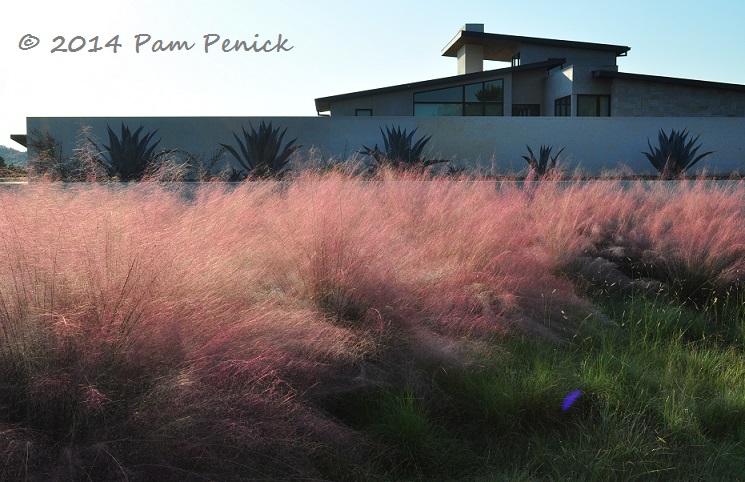
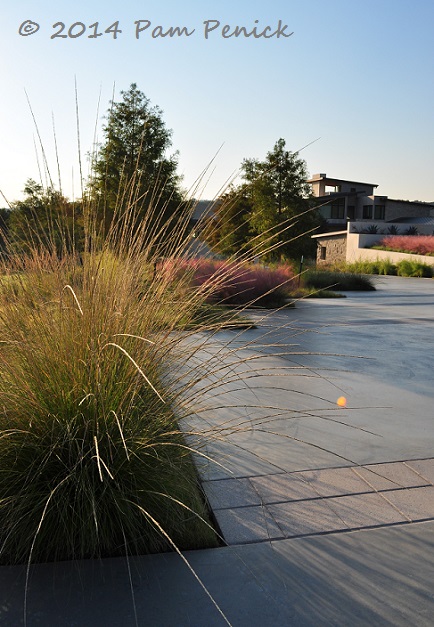
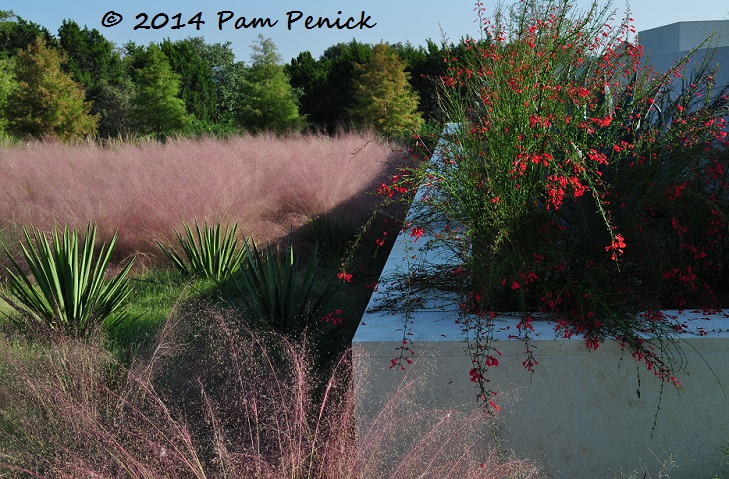
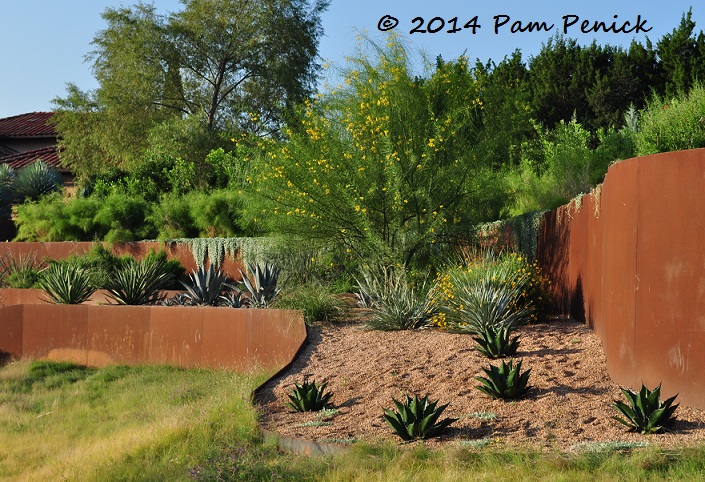
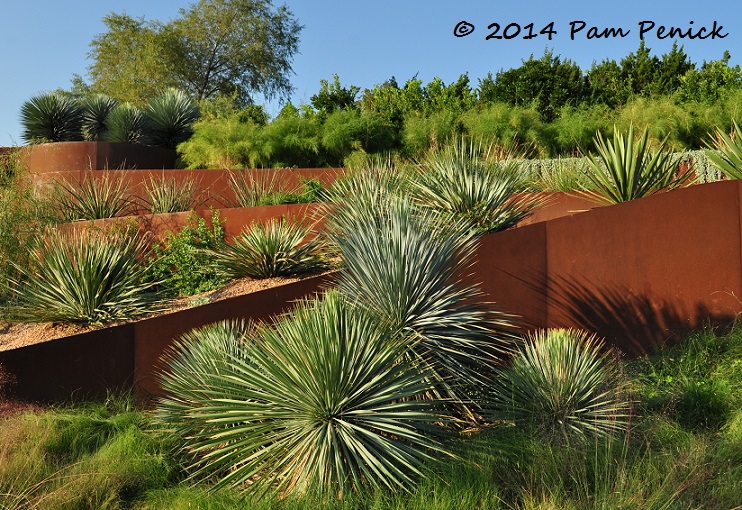
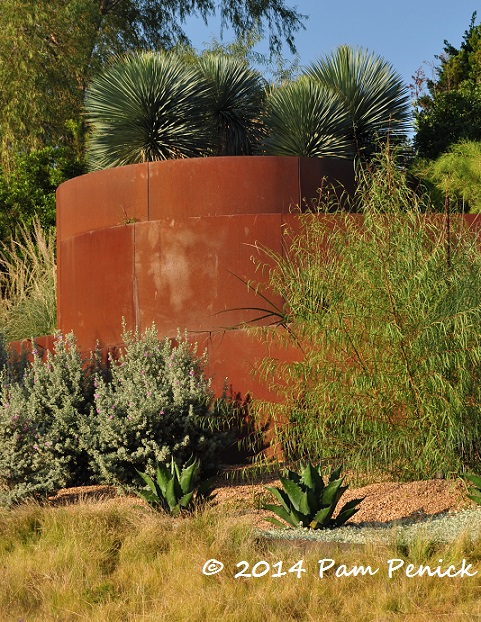
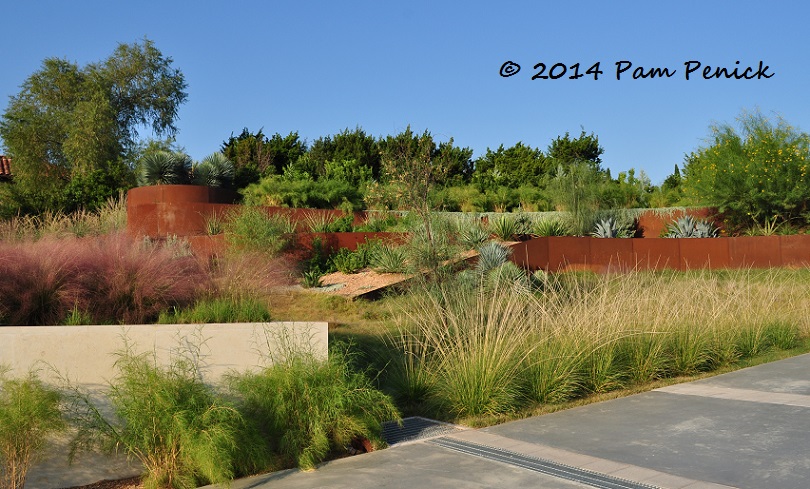
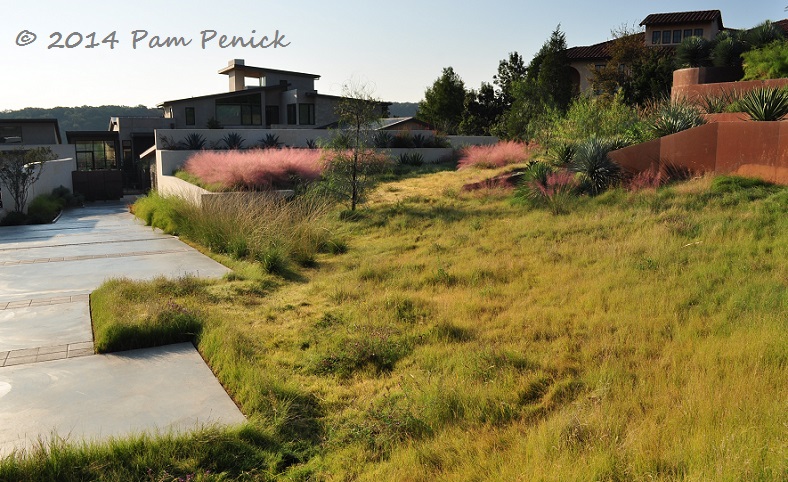
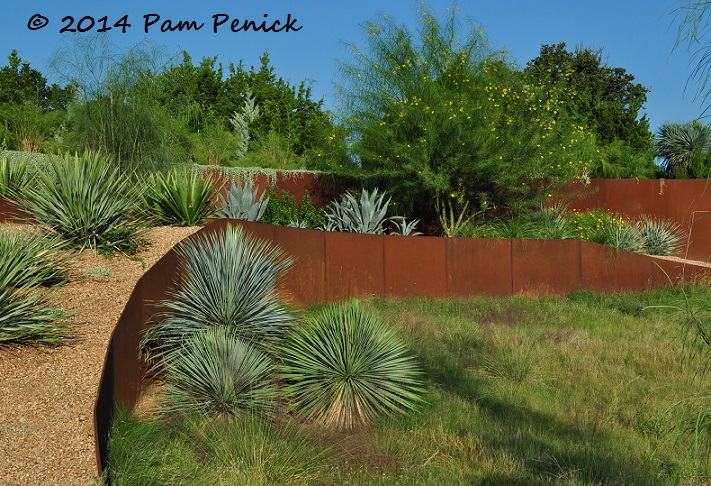
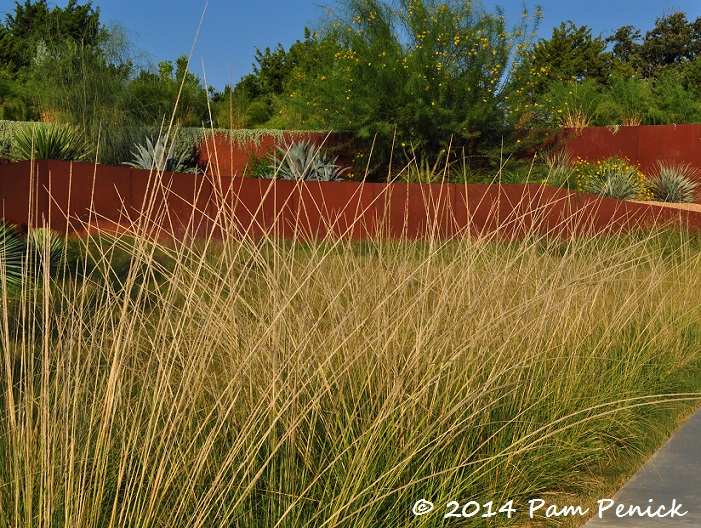
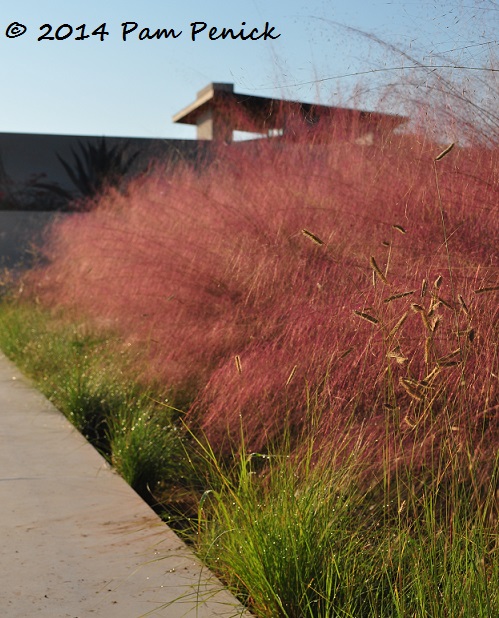
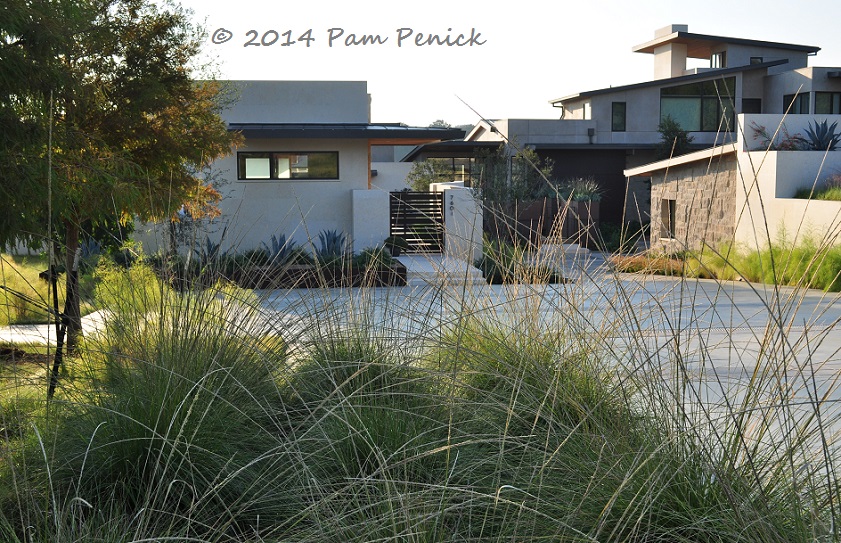
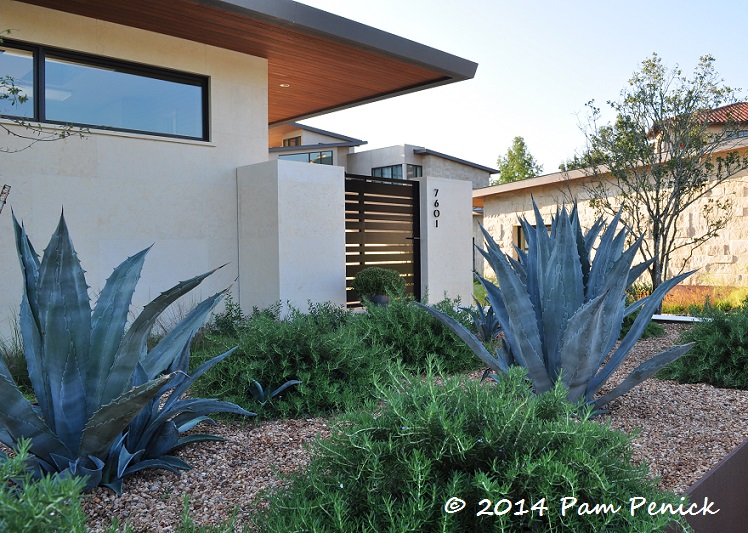
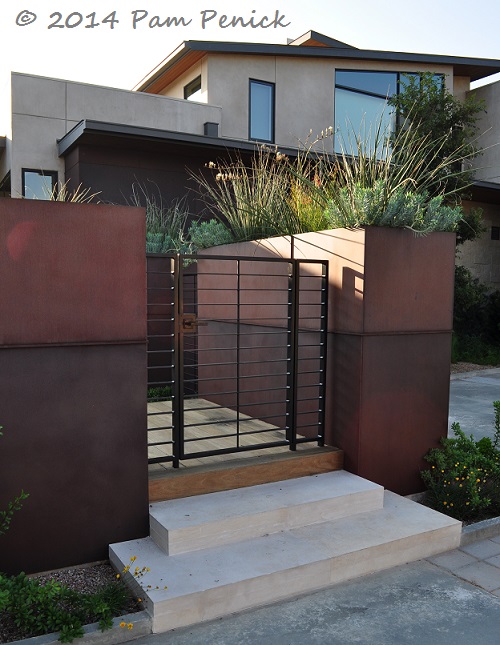
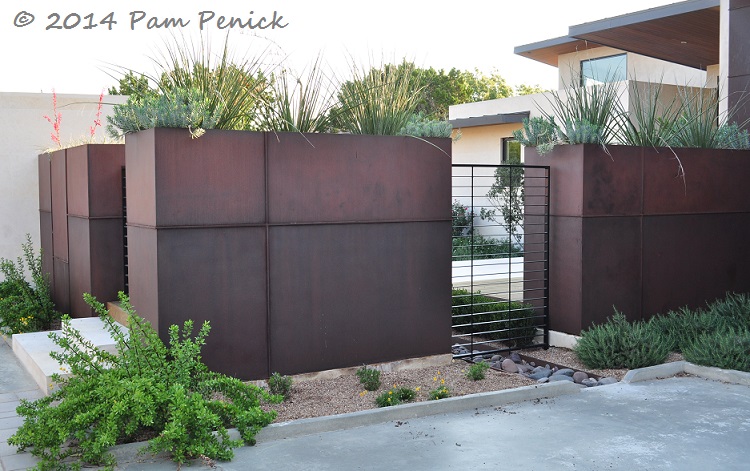
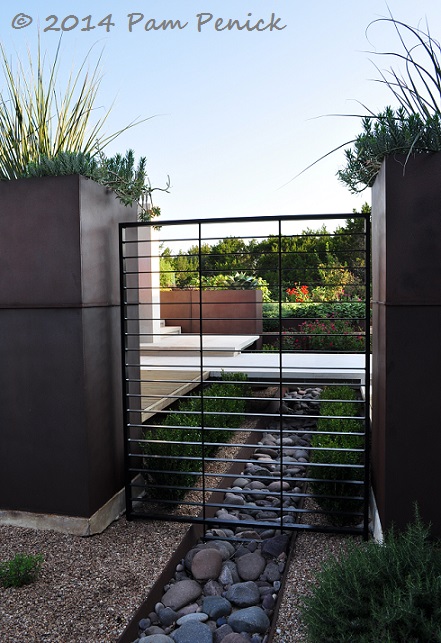
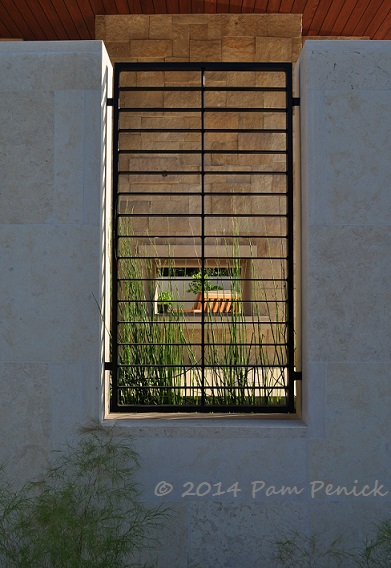
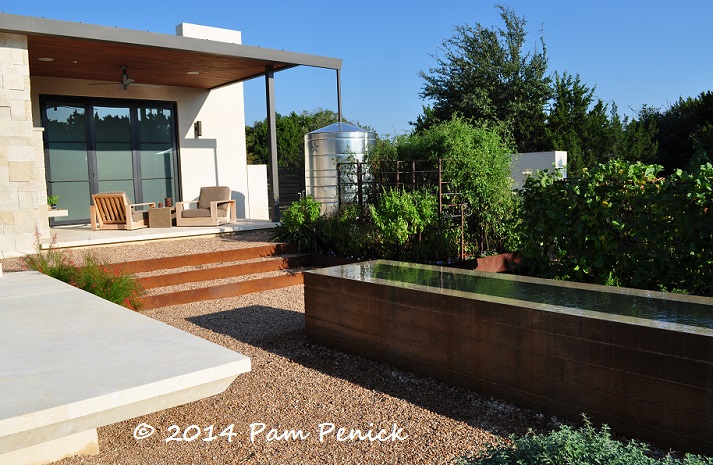
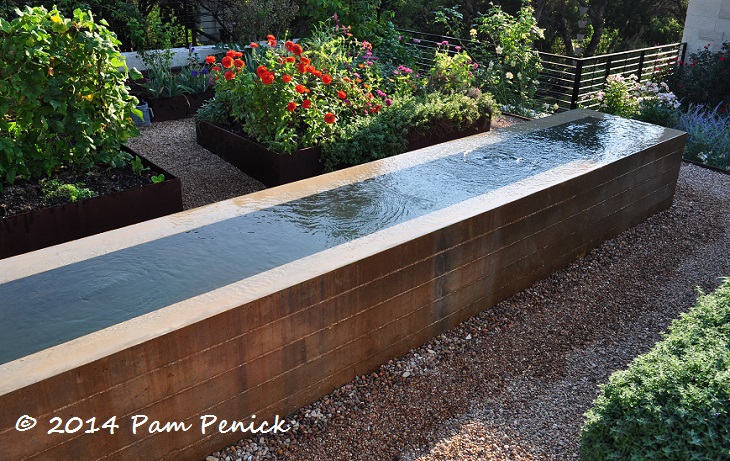
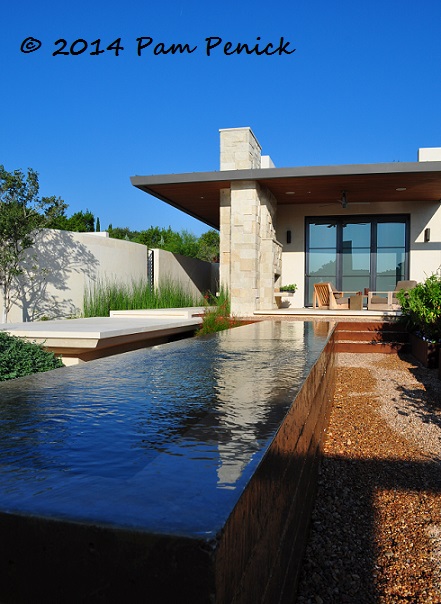
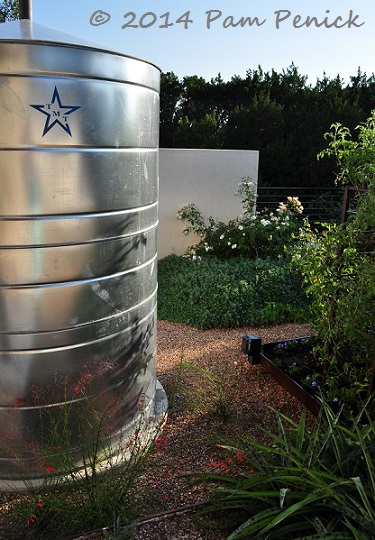
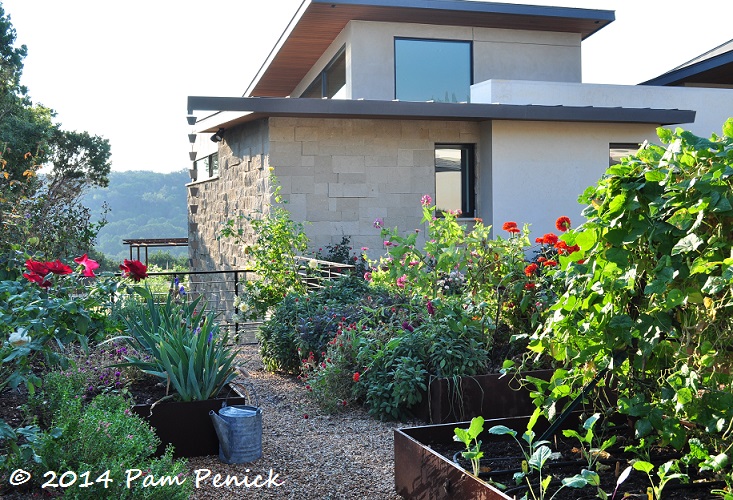
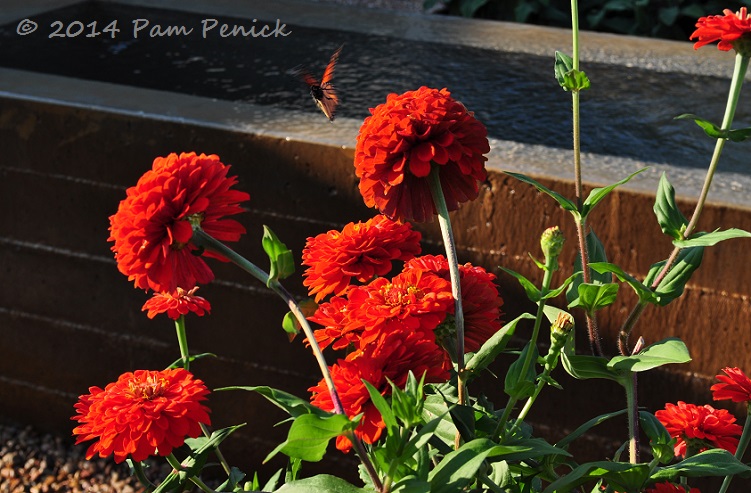
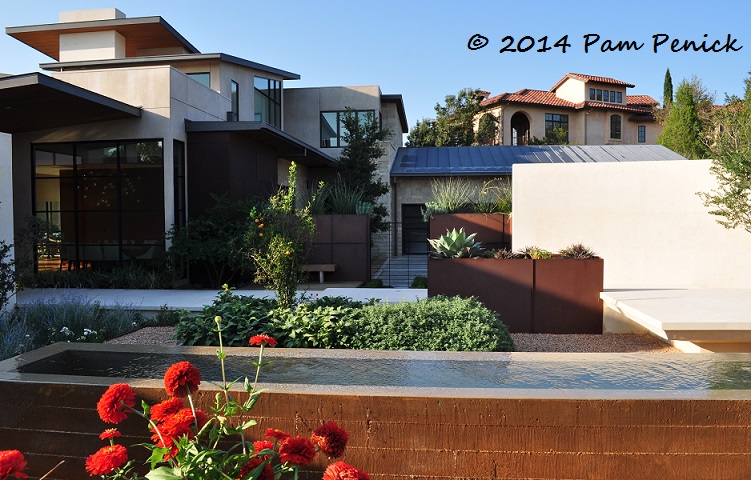
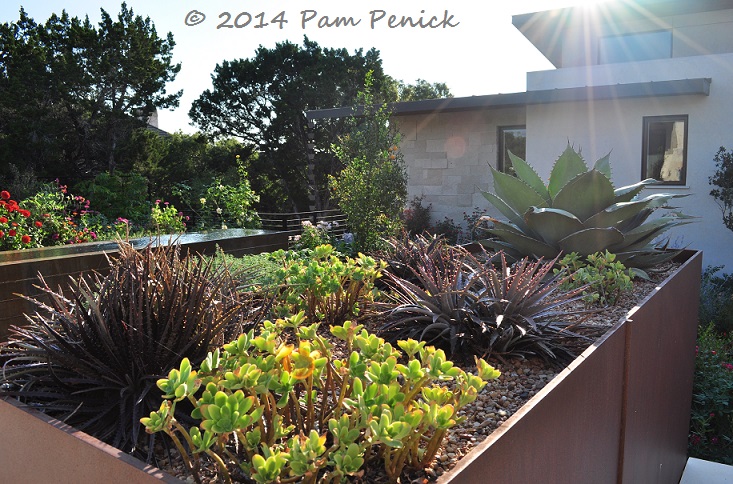
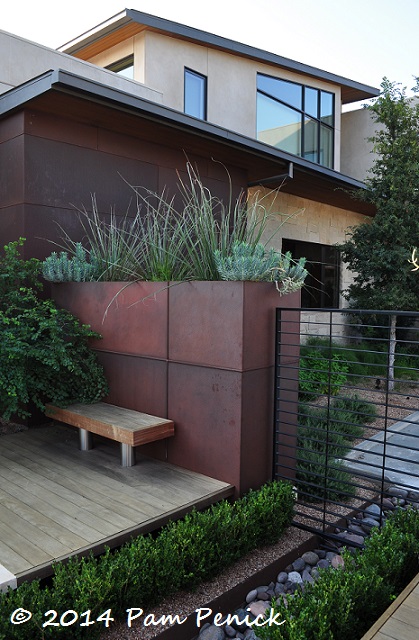
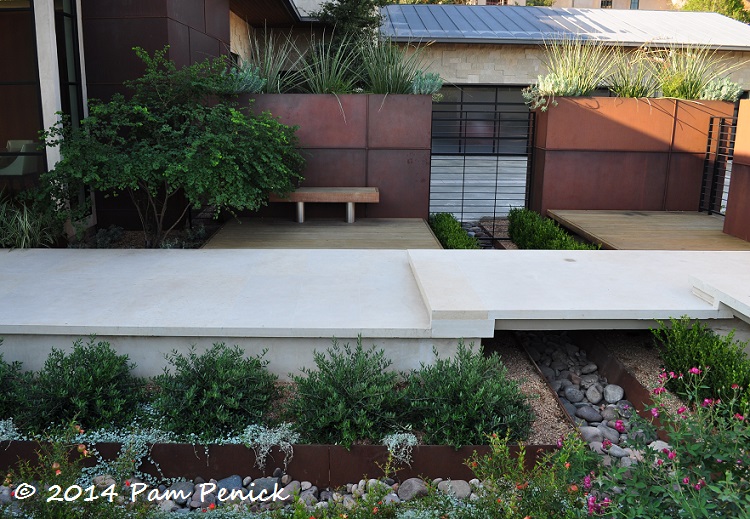
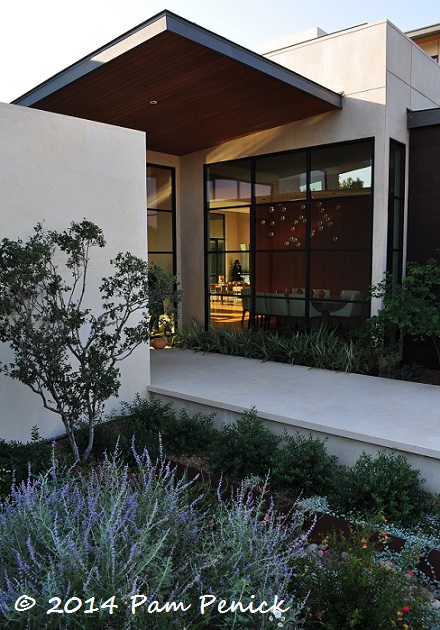
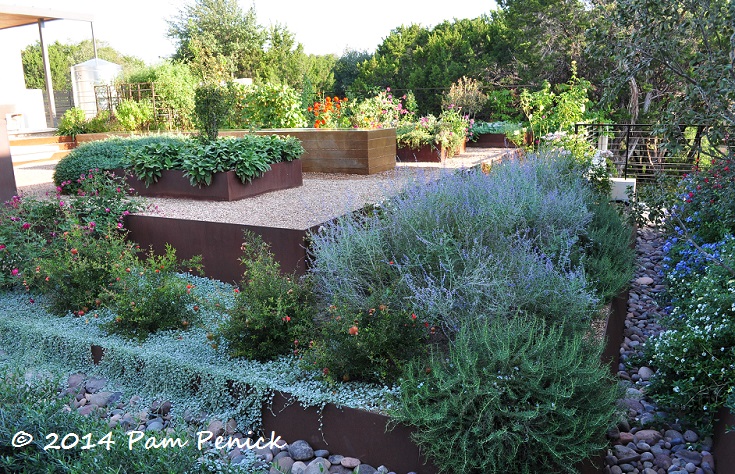
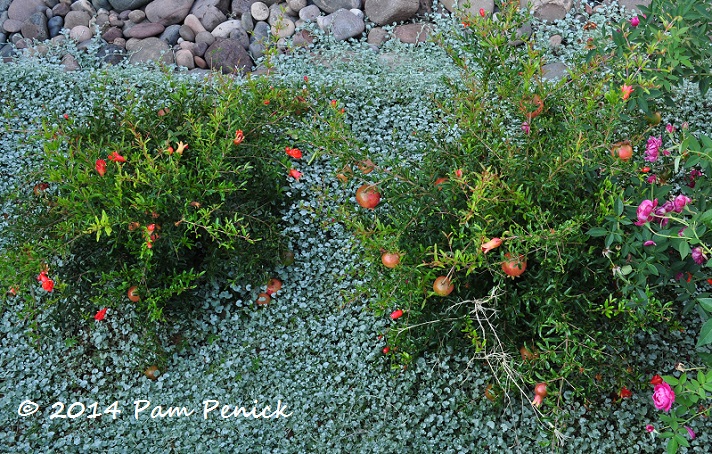
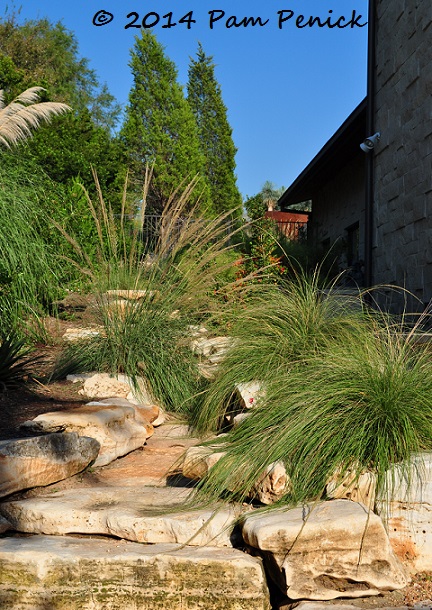
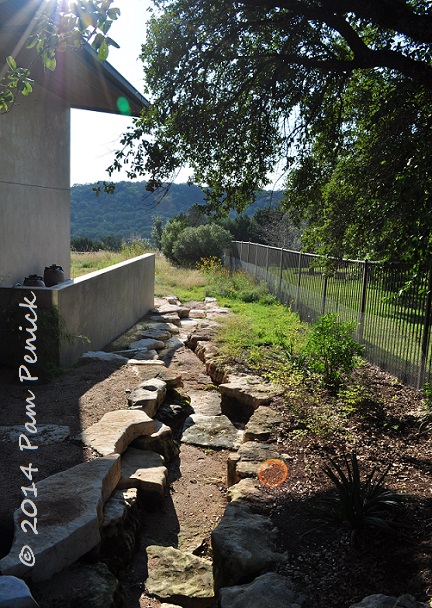
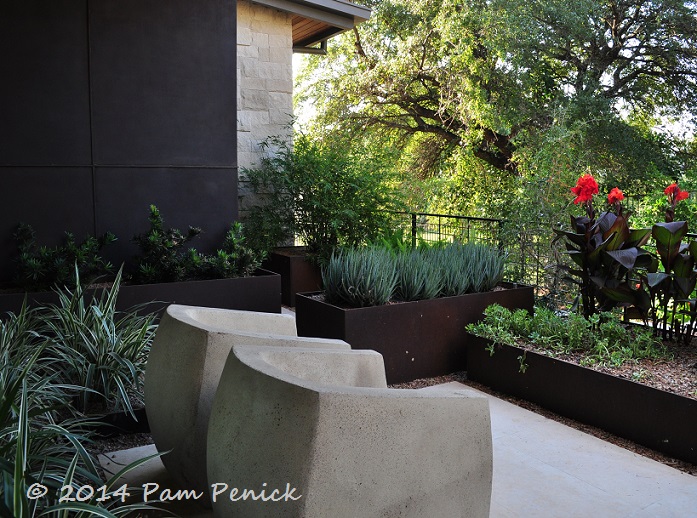
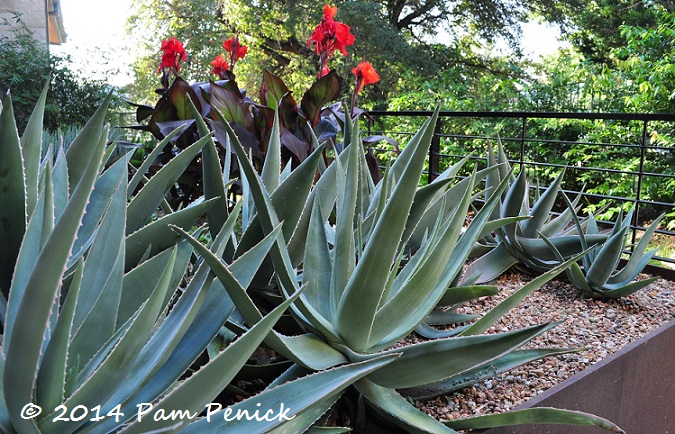
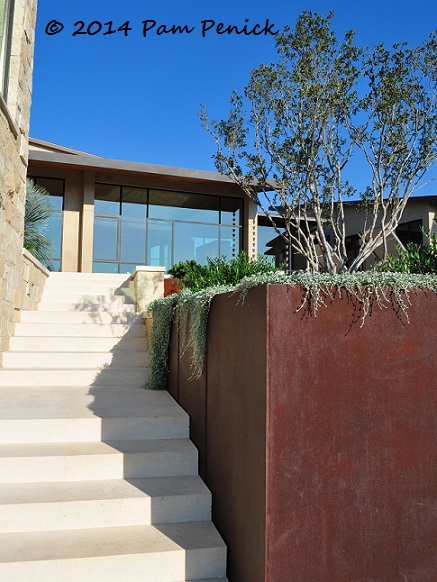
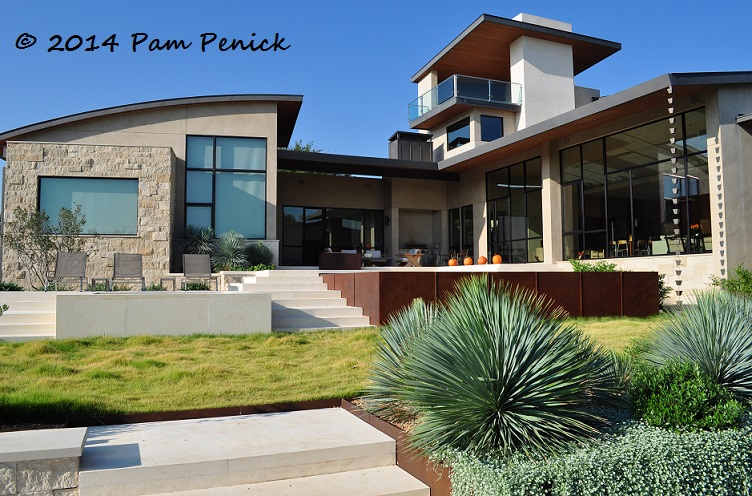
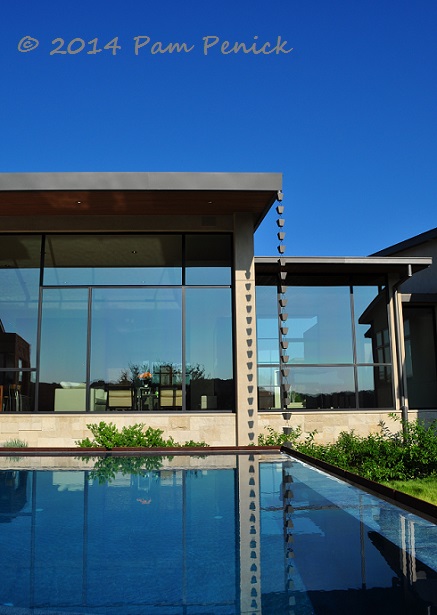
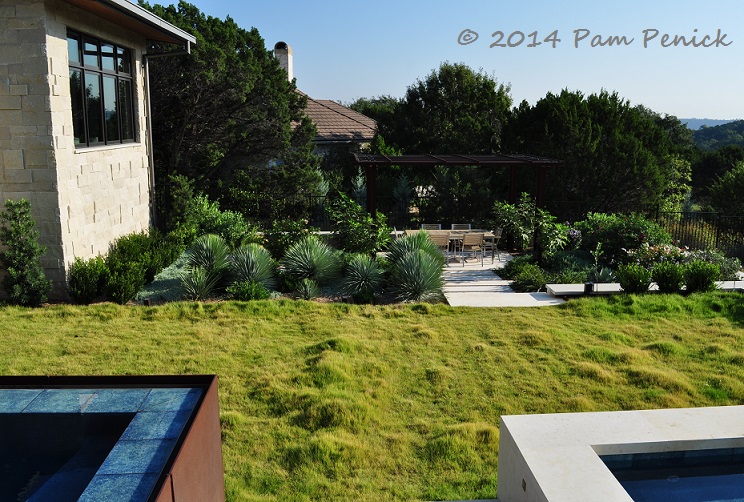
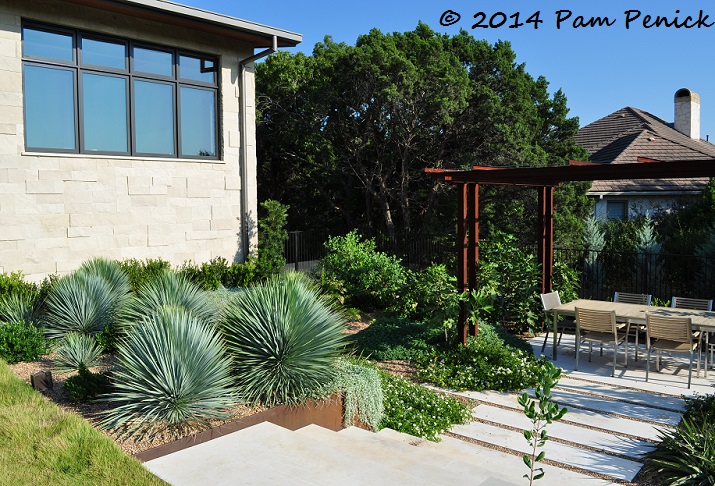
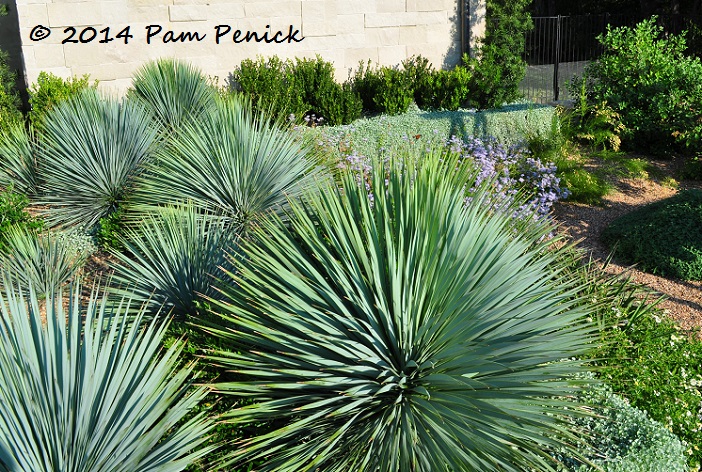
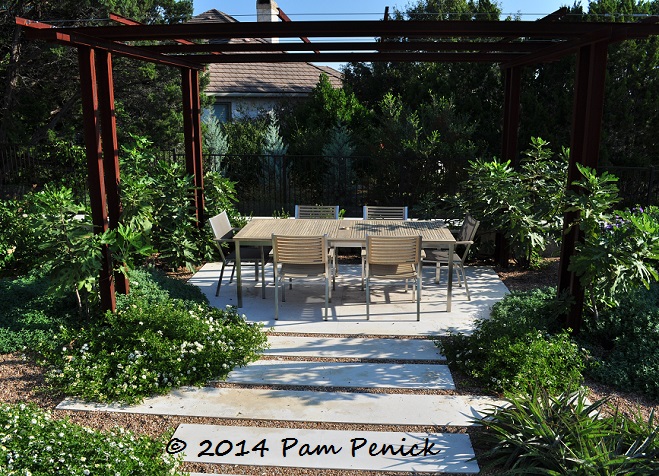
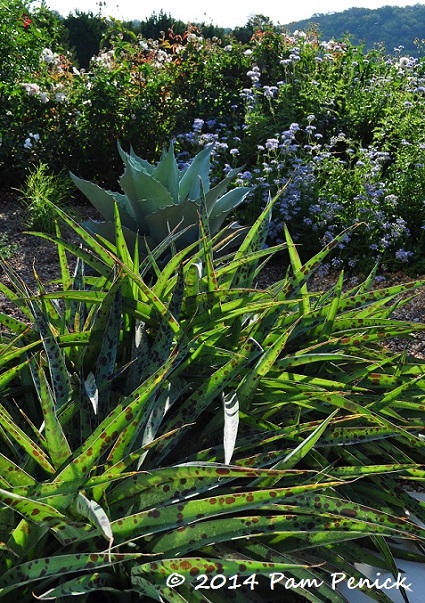
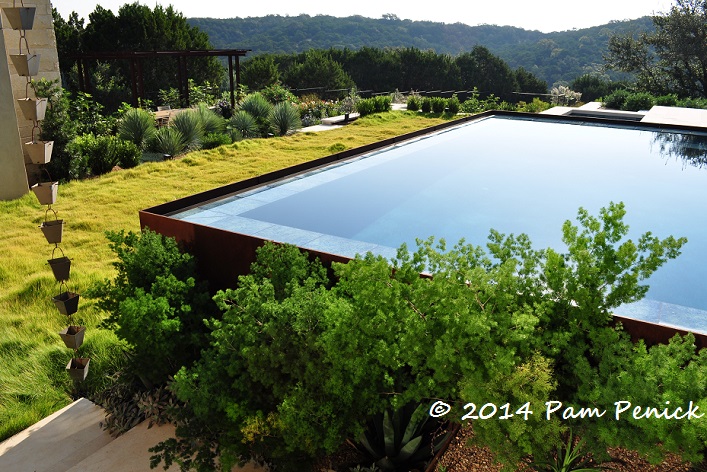
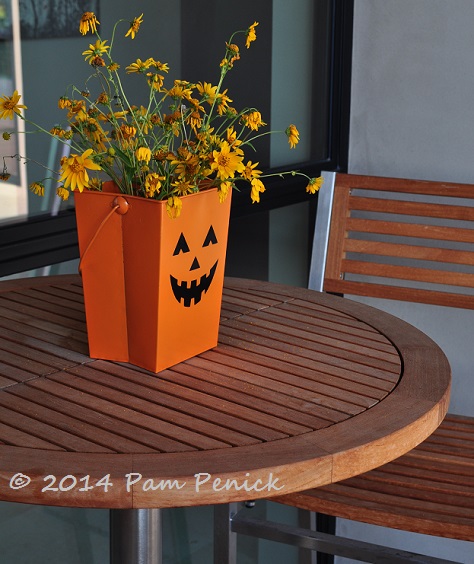
You bet I enjoyed it. This is the prettiest modern style garden I think I have ever seen. It isn’t so cold looking and has so much interest. Just wonderful. Thanks for sharing it.
It proves a garden doesn’t have to be sparsely planted or have a stark design to be modern, doesn’t it? —Pam
Oh my, I agree with Lisa, the prettiest of its kind I have seen, definitely one to keep in the ol’ reference section of my brain. Love it! Thank you, Pam.
My pleasure, Tamara! —Pam
Oh, the things that can be accomplished with unlimited resources. Not many have the taste to use them so well.
Well, I’ve never met anyone with unlimited resources (Bill Gates maybe?), but some do have more than others. I’m always interested to see what people who love gardens and have the means can create when they collaborate with talented, high-end designers like Curt. —Pam
Wow! Gorgeous garden.
I’m thinking this was one you really liked. Modern, but soft…well..and, spiky.
Well done.
I love visiting all kinds of gardens, Linda, and I certainly did enjoy seeing this one. It was something different! —Pam
Love his designs, as always. Dying over that courtyard! I love that the raised planters have such a variety, not just veg (not that there’s anything wrong with just veg). It’s just so interesting!
The courtyard garden is so inviting and also exciting, isn’t it? What a nice thing to see every time you enter or leave your home. —Pam
We walked past this house many times during its construction phase and during planting of the garden. It is wonderful. Curt is undoubtedly one of the best landscape architects in the country-especially with his designs of modern gardens. We can only dream.
I didn’t realize this garden was in your neighborhood, Jenny. It must have been fascinating to watch those steel walls going in. —Pam
This garden is wonderful! There’s a formality to the plant placement that fits the modern style of the house but it’s neither stuffy nor predictable. And it’s a great example of just how beautiful a garden designed to take heat and drought can be.
I agree completely, Kris. It’s also such a nice change from the Tuscan look so popular in Austin’s hilly, upscale neighborhoods. I’d be happy never to see another Italian cypress again. Except in Italy, of course. —Pam
Oh, I love all of those grasses and plantings in the front yard, and, pool aside, I bet their water bill is shockingly low, considering the size of their property. And I covet those steel walls with the planters on top. I bet they could make a great security fence when planted with prickly plants, plus if there are kids around, all those spines would be safely out of reach.
I’ve wondered about training figs myself, considering how fast my fig tree has grown, and I wonder how successfully they’ll cover that trellis. Were there wires not visible in the picture to train their branches horizontally to make “walls”?
Lori, the figs were tied or wired to the arbor posts. I assume they’ll be trained up the posts and then across the arbor just as you’d do with a flat espalier. If I hear anything different from the owner I’ll be sure to share it. —Pam
Lori, I did hear back from the owner about her fig arbor, which she terms an experiment and is based on one she admired in New Zealand. Here’s what she said: “The goal is to clip them so that the foliage is on the top of the arbor, not enclosing the arbor sides. They got trimmed a couple of times this summer but obviously need a lot more training…and need to grow taller. After they lose their leaves this winter it will be a good time to evaluate. A couple of them are tied to the vertical posts as part of the training.”
So there you have it. It sounds like a fun experiment, doesn’t it? —Pam
Incredible- thanks for the tour. That is so inspiring to see that soft lawn and the mixture of soft and spiky all around. I’m refreshed just having read your post.
I’m glad you enjoyed it, Bonnie. —Pam
It’s very interesting to see the shapes and colors of plants used as a design component a modern garden. I appreciate the tour.
Do you happen to know what the yellow flowering small tree is in the fourth photo down? I’m wondering if it’s a Palo Verde ‘Desert Museum’, a tree I’ve never even seen in person, but am searching for.
I assumed it was our native retama (Parkinsonia aculeata), Ragna, but if I can get an ID from Curt I’ll let you know for sure. Update: Curt says it’s a ‘Desert Museum’ palo verde.
By the way, if you ever get up to Georgetown, Texas, you can see ‘Desert Museum’ palo verdes in the parking lot of El Monumento. —Pam
Just popping back in to thank you for finding out what the tree is. BTW, your post on the beautiful landscaping around El Monumento Cafe was where I was introduced to ‘Desert Museum’ … 🙂
I’ll take it! What a wonderful garden, lots of rust structure but an amazing array of plants too.
I’m glad you enjoyed the tour, Loree. —Pam
Wow! There’s a lot of steel in them there hills! I would have loved to see the construction of the hardscape. It would be interesting to see it in 50 years from now. I am a bit conflicted on the steel…maybe too much? But it is beautifully softened by the grasses. I do love those grasses. And the turf is wonderful. It really softens those hard lines. Thanks for sharing! ~Julie
Thanks for your thoughts, Julie. Your comment got me wondering: do you think many residential garden designs are given such long-term consideration as the half century you mentioned? I’d be surprised. The challenges for any garden’s longevity, I think, are changes in ownership, gardening tastes, and climate conditions (like drought). Few gardens make it past the 20-year mark unless a committed owner stays put that long. —Pam
It leaves me speechless and breathless.
Breathe, Shawna! 🙂 I’m glad you enjoyed the post. —Pam
Spec. Tac. U. Lar! Thanks for the tour of a fabulous property. Very, very well done.
My pleasure, HB. —Pam
It is always inspiring to see what can be accomplished with an overall design plan and a healthy budget in combination. I especially appreciate the use of native and well adapted neighbor plants in combination with what I suspect is an elegant rainwater storage system. Isn’t this what xeric design teaches in a nutshell? Take any/everything you admire from your travels elsewhere and recreate it subbing in plants from your own locale. This garden looks very Central Texas in many ways and very worldly in others. Best of both!
Thanks for your thoughtful analysis, Deb. This garden has good “parents”: a well-traveled owner with an interest in gardening and a good eye, and a landscape architect designer who is not only good with structure but knows a lot about native and well-adapted plants and how to make them shine. —Pam
Wow! The first word that came to mind. Your photography captured this garden beautifully.
Thanks, Jane! —Pam
Gardens like this always make me ponder my mental distinction between a garden and a landscape. I love the aesthetic here but I could never have it in my own home because I would always be adding new plants, rearranging stuff, and breaking the clarity of the design. I guess I just have to embrace my inner cottage gardener.
Different styles of gardens are what make the world go ’round. Rock your cottage garden, Astra! —Pam
I have been looking for drought tolerant grass for my part sun, part shade yard. You state here that the zoysia is drought tolerant. I understood that zoysia requires a lot of water. Is this a particular strain of zoysia? Thanks.
Gayle, I don’t know which variety of zoysia it is, but generally the coarse-leaf ones are considered the most tolerant of drought. See this webpage about zoysia grass from Texas A&M. You don’t mention where you live, but if in Texas I’d give Habiturf a try if you have enough sun. See the Wildflower Center’s Habiturf page for complete information about growing it. —Pam
Wiping the drool off my chin…
This is my style…too bad I don’t have the moola! 😉
This IS your style, and you’ve already created it for your own stylish ranch! Hey, smaller is easier to manage, Heather. 😉 —Pam
I was thinking there’s no way this landscape design was added to an existing house, so I’m glad Jenny confirmed that question. What a wonderful example of the architect and LA working in unison. Love those formed concrete chairs and the board-formed trough. Really nice work, Pam, by you too!
Thanks, Denise. The homeowner told us the “concrete” chairs are actually fiberglass or some other lightweight material. Naturally Curt and I had to test them because they looked just like concrete, and sure enough, you can lift them easily. —Pam
Pam, that’s a great, dare I say sexy, looking garden! Please put that on the list of gardens to toru for the ATX garden bloggers reunion…
Thinking ahead, are we, Andrea? 🙂 —Pam
What a spectacular garden and yet all those intimate areas too! A rare case of money and taste combined.
It’s dynamic and lovely and a lot of fun to see! —Pam